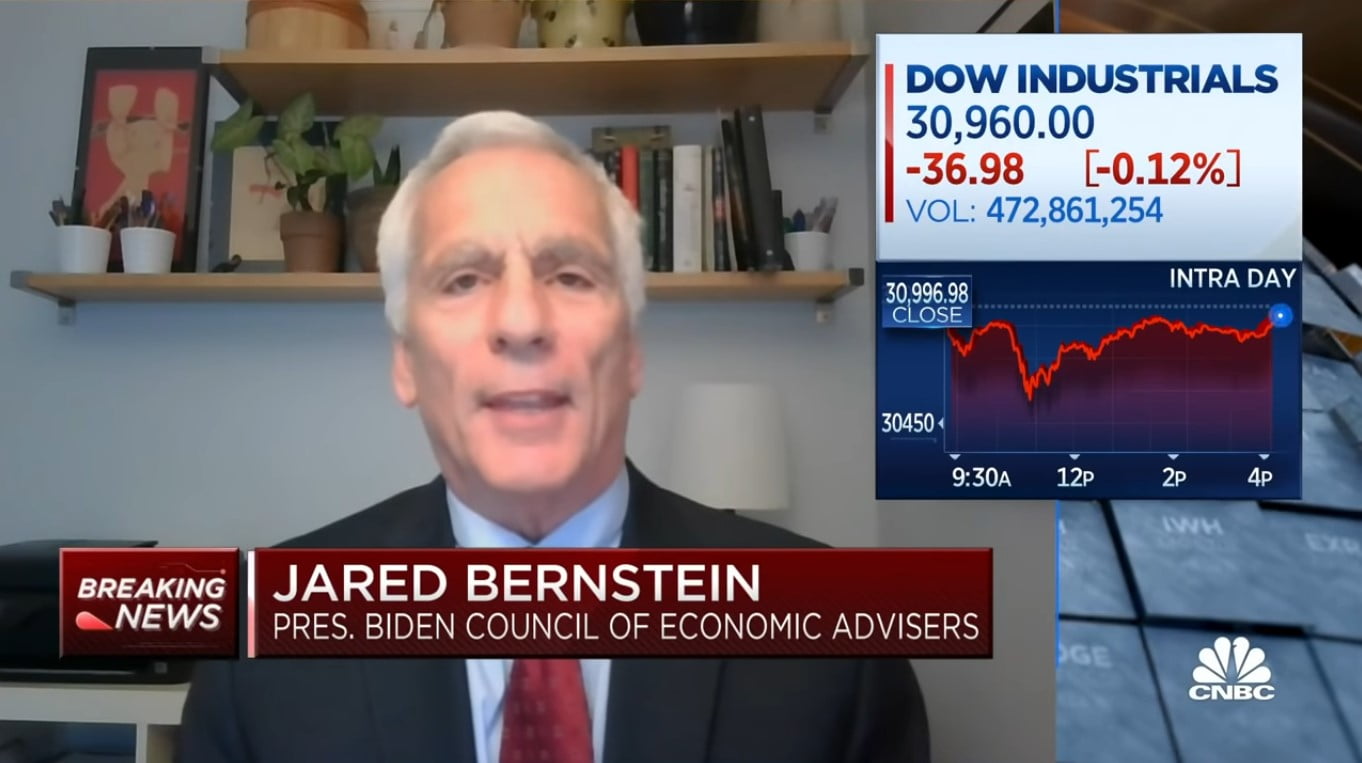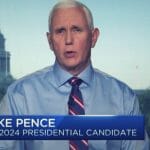CNBC transcript: The Council of Economic Advisers member Jared Bernstein speaks with Kayla Tausche live during CNBC’s Capital Exchange today
Q4 2020 hedge fund letters, conferences and more
WHEN: Today, Wednesday, February 3
WHERE: CNBC’s Capital Exchange, “The New Economic Agenda”
Following is the unofficial transcript of a CNBC interview with Jared Bernstein, member of the Council of Economic Advisers, and CNBC Washington Correspondent Kayla Tausche live during CNBC’s Capital Exchange today, Wednesday, February 3rd. Full video will be available at cnbc.com/capital-exchange.
Interview with Jared Bernstein
KAYLA TAUSCHE: First, we welcome Jared Bernstein, a member of President Biden's Council of Economic Advisers. Jared, it's good to see you. I want to start with the discussion around stimulus. We have heard in the last several days and in just the last several minutes even from Democrats that the need continues to go big. The White House has said that in recent days as well even as Republicans suggest that something more targeted is warranted by this moment. So where do you see the most fertile ground for compromise, what is a compromise price tag look like, and what programs might be ready for an edit?
JARED BERNSTEIN: Well, I think that's the key factor in everything you just described, Kayla – by the way, it's great to see you and great to be with you and great to have a chance for us to talk for a few minutes because usually we're all very compressed on CNBC. So I think the key thing there is the urgency, with which we need to get a package out that's commensurate to the size of the dual crises that face us. They said in the introduction of course, controlling the virus, distributing the vaccine, and finally, launching a robust recovery that has eluded us thus far. It's been much more a wait and see up and down kind of affair. And there, I think, to get to your political question there's actually lots of common ground. Now of course, there are places where we disagree and we can get into that, but I know Josh is going to be on from the Business Roundtable, they've certainly supported components of the plan. The Chamber of Commerce, along with the American labor movement – we've got Republican mayors across the country. Donald Trump and George W. Bush chief economists have said this is the kind of plan we need to get into the system quickly. So, in terms of sort of top line price, it's really not the way we think of it. I don't think that the right way to kind of do this arithmetic is say do you want to be at X or half X. What we want to be at is something that's large enough to address the crisis with alacrity and certainty. The danger is not going too big. The danger is going too small.
TAUSCHE: But the political reality, Jared, as you know well is that X’s might not be possible in Congress. Half X might be a more realistic proposition. So I'm wondering what you think might be, for instance, an appropriate income level for people to qualify for those direct checks. Whether minimum wage could be shelved for a future package. I mean how do you see the $1.9 trillion American rescue plan, being whittled down into something that is realistically passable on Capitol Hill?
JARED BERNSTEIN: Yeah, I think whittling down is the enemy of what we need to do here. I think whittling, I think, you know, inaction, I think wait and see, to me, and I think more importantly to the President, you know, that's the enemy of controlling the virus, distributing the vaccine and launching a robust recovery. So, again, I think the way to think of this is less kind of top down more bottom up. So let's pick an area where we disagree where Republicans would take this out of the plan. State and local. State and local assistance. Now states and localities, they have to budget – they have to balance their budget every year. They cannot run deficits. We've already seen them laying off well over a million workers disproportionally in education. So if we're going to reopen the schools, if we're going to control the virus and distribute the vaccine, if we're going to make sure that we not only rehire educators, but protect other public sector workers – cops, firefighters, those in public safety – I think it's glaringly obvious to the President that we need state and local relief. Another example, making the child tax credit. This is a refundable tax credit that goes to low income people – you talked about income levels. This plan, which is in our plan – it's not in the Republicans offer – this plan, it's 120 billion. This cuts the child poverty rate in half. Now, that's some pretty impressive targeting. Now I know what you're alluding to is the direct impact payments or the rebate checks, and those do go up to families in the middle class. But you know, newsflash. Those families have also been experiencing really, very pressing economic hardships. Not just around rent or mortgages, but also around job loss, around wage loss, and they need help too. And that's also in the plan.
TAUSCHE: Jared, today, President Biden said he thinks he will get some Republicans to vote for this package. But I guess the question is, will he get 10 Republicans to vote for the package, or will he get a handful so that the White House can say that it passed with bipartisan support, but that you would still need to use budget reconciliation as a tool to actually get it across the finish line?
JARED BERNSTEIN: Well first of all, you just made a point that alludes a lot of people, which is reconciliation doesn't mean no Republicans joined the plan. And in fact, there's been many examples throughout history where reconciliation has actually been bipartisan. Somebody pointed out to me yesterday that the Child Health Insurance Program, or CHIP, has done reconciliation with votes from both sides. So I think that that's something to keep in mind.
TAUSCHE: Not 60 votes, importantly here.
JARED BERNSTEIN: It's a fair point. And I think that when it comes to sort of political nose counting, I'm just not the person you want to talk to about it. I'm thinking much more about the magnitude of the package. But that is, you know, key to the politics. I mean basically, the President has been open and, you know, by the way, this didn't start a couple of days ago, we've been talking to Republicans for weeks. And by the way, a lot of those Republicans were pushing some of the very checks that you're now hearing folks criticize. And there's, as I said, there's a lot of common ground when it comes to virus control, when it comes to helping businesses. So I think that the key thing there is that the President is willing to exchange information and ideas in any way that accomplishes the goals he set out for this package. Not moving quickly and not moving with the force to finally put this virus behind us and launch this recovery. That's the part that's not acceptable to him. But if anybody has any better ideas in how to get there more quickly, of course, you know, not only is he willing to listen to them, but he is listening to them.
TAUSCHE: So would you say that talks are actually going more productively behind the scenes than maybe these public statements would seem to signal?
JARED BERNSTEIN: I don't know enough about behind the scenes to really, you know, confirm that. But if you listen to statements that Susan Collins for example said coming out of the meeting that they had the other night, she was echoing a lot of the points that I've been making here today which is that both sides share the urgency of the moment. Now, you know, I don't know that she speaks for the whole caucus, but I think that those folks were bargaining in good faith in that meeting. And I think the difference there is are you willing to go far enough to meet the demands of the moment? So again, the American rescue plan is not calibrated from the top down. You didn't start with 1.9 trillion and say okay, let's fill in, see how we get there. It's calibrated from the bottom up. What will it cost to reopen schools? What will it cost to provide the relief to not just low income families as I mentioned with the child tax credit, but middle income families with the direct income payments? What will it take to control the virus and distribute the vaccine? And if you sum up the cost involved in that the full spate of measures that it will take to get this economy back on track and to put this virus behind it, you end up with the American rescue plan from our perspective. Now, I have not seen a convincing argument that says you end up accomplishing those same goals for, you know, one half or one third of that. And I think what the President is trying to say is that folks need to come at this from that perspective. Not from a top line perspective. You spend two, we want to spend one. More from a perspective of what will it take to get the job done. That's our plan.
TAUSCHE: Jared, you mentioned that you're not focused on reconciliation and political nose counting and how you actually get to the votes, but which avenue you do choose to get this passed does impact what parts of the President's agenda on other issues you can actually pursue as well. Because reconciliation is not an unlimited tool. You get two shots at it this year, and you'll get one shot at it in future years if there's a budget passed then, too. And so, if you choose to use reconciliation for COVID relief, I'm curious how the administration would choose to use its second opportunity at reconciliation. Is that to expand the public option and to pursue some sort of broader healthcare policy, or is it for the build back better infrastructure and clean energy agenda? Which do you choose?
JARED BERNSTEIN: Well, no, it's interesting you should say infrastructure, because while there is – infrastructure is obviously something that President Biden has worked on his whole career – because we've been focused on the rescue plan, we haven't talked a lot about some of our plans in that regard, although the President has certainly leaned into those investments in the clean energy space. So, I know you asked a political question, let me get to that. I remember testifying in Congress a couple of years ago, and it was about the infrastructure deficit in this country which is, you know, a very, very deep one. In terms of public investments in capital goods and public goods. And after that – and I was quite critical of the Trump administration's lack of an infrastructure plan – and after that testimony to Republicans – I'm not going to name them because it was a private conversation – pulled me aside and said, we really want to do infrastructure too, but the President doesn't have a plan. So when we're talking about infrastructure, clean energy, childcare, many of the elements of the building back agenda, it is not at all obvious to me that that has to go the route of reconciliation. And if we're talking about infrastructure, it's actually pretty obvious to me that we probably won't. So I wouldn't be so quick to assume that the kind of partisanship would be as deep as maybe folks might think in some of those areas. And again, you know President Biden really is bringing a different climate in terms of political negotiations than existed in this town for the past four years. And while there were definitely differences in that discussion the other night, the American rescue plan – I've talked about some of them already – there was a spirit of shared urgency. And that's going to, I believe, that's going to convey over to the discussion about infrastructure, about climate, about the care agenda, about health care and education. So, I'm, you know, at least until proven otherwise, I'm optimistic.
TAUSCHE: There was a CBO report that we referenced earlier that said that the U.S. economy would get back to pre-pandemic growth by the middle of this year. Not pre-pandemic unemployment until 2024, but each party seems to be reading that in a different way. Republicans say it's proof that there doesn't need to be some sort of large rescue package, but you and Secretary Yellen have both said that it underscores the need for this urgency. But casting the CBO report aside, I'm just curious what data set you are using internally at the White House – as the CEA is what is supposed to inform the President, the White House and policymaking – what data set internally are you using and what does it tell you about when exactly the U.S. economy is going to get back to pre COVID levels?
JARED BERNSTEIN: That's a great question. The answer is not data set. Data sets, plural. I've been perusing as my colleague Heather Boushey as well, and the team have been perusing at least 20 different forecasts. And each one has, you know, probably 10 variables at least in it. So, my head is full of this noise. Now CBO came out yesterday with a forecast that was pretty much around what you'd see kind of in the mainstream if you looked at what's out there. A couple of teams are higher than that, a few are lower. But I think the key thing there from our perspective and you got into this in your question is what do these expectations inform us about our plan? Now, the unemployment rate in the CBO projections that came out yesterday, that's going to remain higher than the pre-crisis projections until 2024. Now, it's important to recognize the CBO included the December relief plan, but of course it doesn't include our plan because that's not, you know, what they do. Our plan is not legislated yet. But that means that millions of people will be unemployed for years after this health threat is behind us, unless we take action now. If we look at the GDP from the CBO report in fact, you are correct, the way you put it about growth rates, but the level of GDP doesn't get back to its potential until 2025, unless we implement the American rescue plan, which pulls both full employment forward by a year and hitting potential GDP forward by more than that. So part one is that the economy will not get back to full employment nearly quickly enough without this plan. Part two is that you can't judge our plan, our success, in fact, I would argue this for pretty much everything we're going to be trying to do in this administration, simply by looking at GDP. Not even looking at the unemployment rate. Those things are necessary but they are not sufficient. Necessary but insufficient. And what do I mean by insufficient? I mean insufficient to reach those in the bottom leg of the K in this K-shaped recovery. For far too many people GDP growth has been a spectator sport for decades on end, and our policies have to recreate the connective tissue so that economic growth generates broadly shared prosperity and racial equity. And that's what this rescue plan is about. And that's what building back better will be about.
TAUSCHE: And that's a good segue Jared to an audience question that I wanted to get to before my final question for you, which is from Lakeisha Williams. She's a senior payroll analyst at Oasis Petroleum and she asks, What are the targeted goals of the new administration to bridge the gap between Wall Street and Main Street? I know we could probably have a 30 minute conversation of our own just about that question, but I'm curious sitting here today, if you had a short punch list of how the administration would plan to tackle that, what would it be?
JARED BERNSTEIN: Yeah, you know, it's a great question from the Lakeisha. I think the problem is quite deep and quite multifaceted. So while, you know, the short punch list – I do have a punch list, I don’t know how short it is. I think the best way to speak about that is in terms of kind of the categories that do precisely what I said in my last answer to you, Kayla, which is to, how do you rebuild the architecture that used to link GDP growth to middle class prosperity for many people but, in fact, never linked GDP growth to the prosperity of persons in communities of color. And that is a multifaceted agenda. It involves making sure that people have access to health care, to childcare. It makes sure that exclusionary zoning in housing is absolutely a thing of the past. It makes sure that every kid can achieve their potential by accessing the quality education they need and not just K through five or eight or 12, but through college and grad school, that's an opportunity agenda. It's an agenda that allows people to realize their economic potential in a way that they've been blocked for years because of racial discrimination – it has been systemic – and because of the kind of disconnections between say Wall Street and the rest of the economy that's implicit in Lakeisha’s question. At the same time, if we don't address some of the structural economic problems that have really hurt the US economy's resiliency, it'll be much harder to get there. So climate change. Climate change is a massive cost, not just on the future economy and on the current economy. So, the Biden plan goes very, very deep in that direction. And again, this is the top level punch list. There are many things that come underneath that. Standing up an accessible childcare sector is another part of that agenda. So that's just some of the ideas that I think help rebuild that connective tissue.
TAUSCHE: And you're certainly going to have your work cut out for you there Jared, but I'm thinking in my final question, I'm recalling the confirmation hearing for Tony Blinken for a Secretary of State where he praised the Trump administration's policy on China. He praised the Abraham accords peace deals in the Middle East and said that a lot of those things he wanted to keep intact and so I'm wondering from an economic perspective, as you're talking about this wholesale structural rebuilding of the American economy, are there any policies from the Trump administration that you think are positive legacies that you think we should keep?
JARED BERNSTEIN: Yeah, it's a great question. You know, I think there's one that I'm not quite sure how to discuss it in the context of the – I think one of the things we learned in the Trump economy, as you know, Kayla, we probably talked about this on the station. I've been extremely critical of the Trump tax cuts. And my main critique, as you know, is that they just shifted hundreds of billions of dollars to folks who are already doing great at the top of the scale very much exacerbating the inequality that I talked about. But at the same time, they did create a certain fiscal pressure. And in tandem with the patience by the Federal Reserve to kind of test the boundaries of some of the metrics that economists used to think couldn't be violated – if we went below 6%, unemployment would start, I mean inflation would start spiraling. And then it was if it went below 5% unemployment, inflation would spiral. Then it was 4%. Well, I think the combination of procyclical fiscal policy and a data-driven Federal Reserve helped deliver an understanding to economists that we can run a hotter labor market than we thought. We can run a hotter economy than we thought. And from the racial equity standpoint that's so important to the Biden/Harris team, that's critical to providing the kind of opportunities I was talking about a second ago and answer to Lakeisha’s question. It's when you get the unemployment rate down to the levels that prevailed pre-crisis that you begin to see opportunities develop for people who are otherwise left behind. So I would say, you know, Trump’s foot on the fiscal accelerator was, you know, really quite terrible in my view from a distributional standpoint. But from the perspective of learning lessons about how hot we can run this economy, actually very important.
TAUSCHE: All right, we'll keep that lesson in mind as hopefully the economy returns to grow this year. For now, Jared, we so appreciate your time today. Jared Bernstein is a member of President Biden's Council of Economic Advisers.













